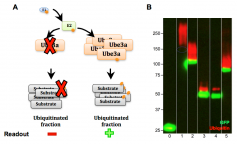
2013/12/09
What goes wrong in Angelman Syndrome? Fruit flies give us the insight
Angelman syndrome (AS) is a severe neurodevelopmental disorder related to autism, which presents also with intellectual disability. The cause of AS is the loss of function in the brain of the ubiquitin E3 ligase coded by the UBE3A gene, which is located on chromosome 15q. Autism is a neurodevelopmental disorder characterized by social deficits, communication difficulties, stereotyped or repetitive behaviors and interests, and in some cases, cognitive delays. Duplication of the 15q locus including the UBE3A gene is one of the most common genomic causes for autism, but the pathogenic mechanisms that underlie autism and AS, due to the excess or lack of UBE3A activity, are still unknown.
Ubiquitin ligases conjugate ubiquitin molecules to their substrates, to influence a number of biological processes, ranging from protein localization, transport, endocytosis, facilitation of protein-protein interactions as well as protein degradation. Eukaryotic organisms use hundreds of E3 ligases to ubiquitinate proteins. Each ubiquitin ligase can have a few or hundreds of substrates. This complex relationship between E3 ligases and substrates confers specificity to ubiquitin-regulated mechanisms in the cell. Loss of UBE3A has been proposed to increase the concentration in the brain of a number of proteins, but none of those has been confirmed in neurons to be ubiquitinated by UBE3A.
Previous research by Ugo Mayor's group at CIC bioGUNE had shown that the orthologue protein in flies, Ube3a, is active during brain development. In 2012, the group of this Ikerbasque Research Professor received a 2-year grant from the American foundation March of Dimes to identify substrates of this ligase. Now, in a new study published in the journal Cellular and Molecular Life Sciences, they have identified Rpn10 and other regulators of the proteasome as direct targets for Ube3a in a neuronal cell culture system. Additionally, they confirm with flies their genetic interaction in vivo. These results place Ube3a as a master regulator of protein homeostasis within the brain and provide new mechanistic insights at a molecular detail. Further characterization of those substrates will be required for a better understanding of both pathologies associated to UBE3A enzyme levels in humans, Angelman syndrome and dup15q-associated autism. Currently no cure exists for either of those disorders.
Figure caption. Strategy to identify ubiquitination substrates of Ube3a. A) We monitored ubiquitination levels of candidate substrates upon overexpression of Ube3a, and compared to controls with either a catalytically inactive version of Ube3a or no overexpression. B) For validation and confirmation of Ube3a substrates we developed a novel method described in the paper.
Citation: Lee SY, Ramirez J, Franco M, Lectez B, Gonzalez M, Barrio R, Mayor U. (2013) Ube3a, the E3 ubiquitin ligase causing Angelman syndrome and linked to autism, regulates protein homeostasis through the proteasomal shuttle Rpn10. Cellular and Molecular Life Sciences. DOI: 10.1007/s00018-013-1526-7. The scientific publication can be found here
See a large version of the first picture





